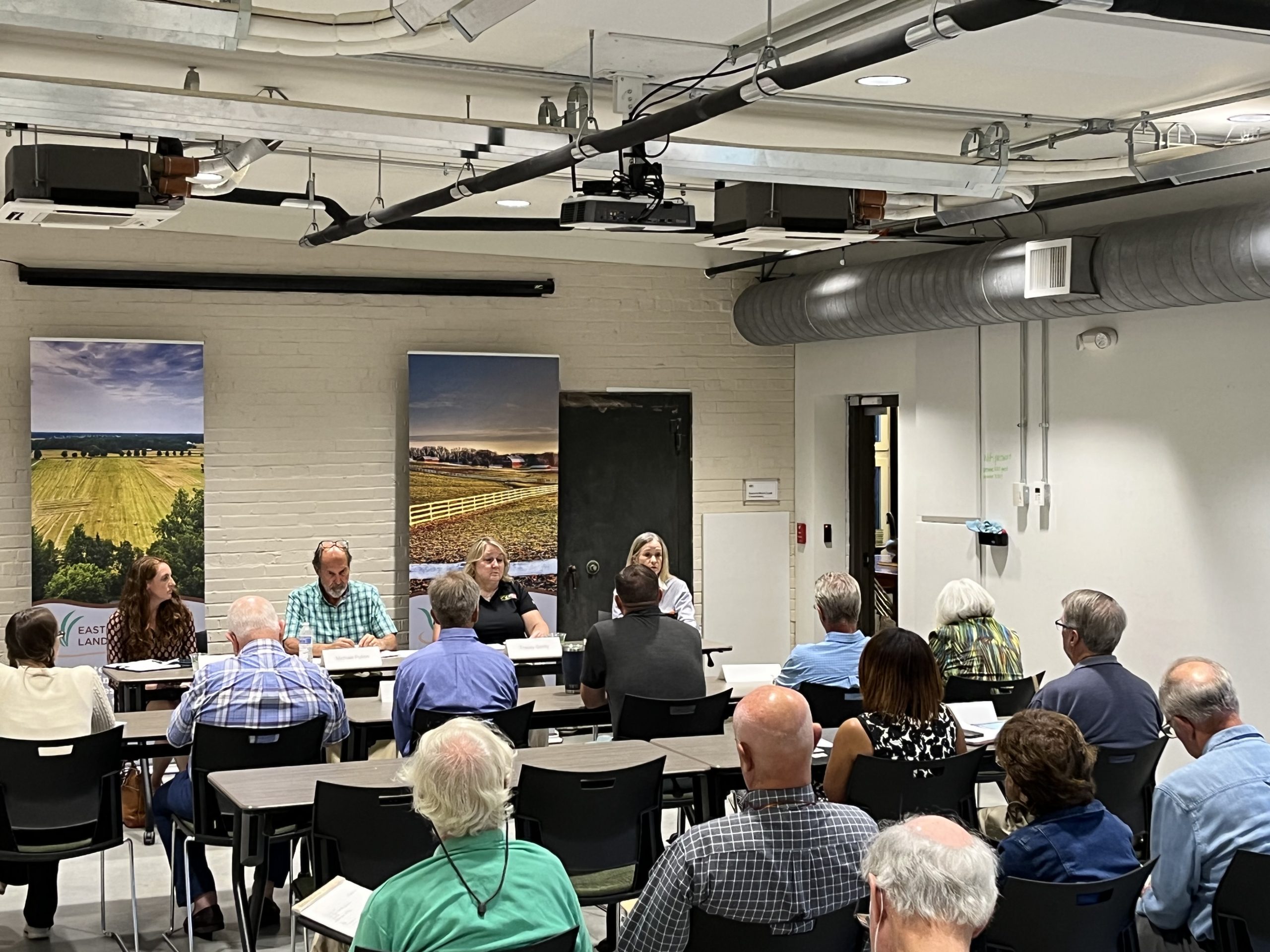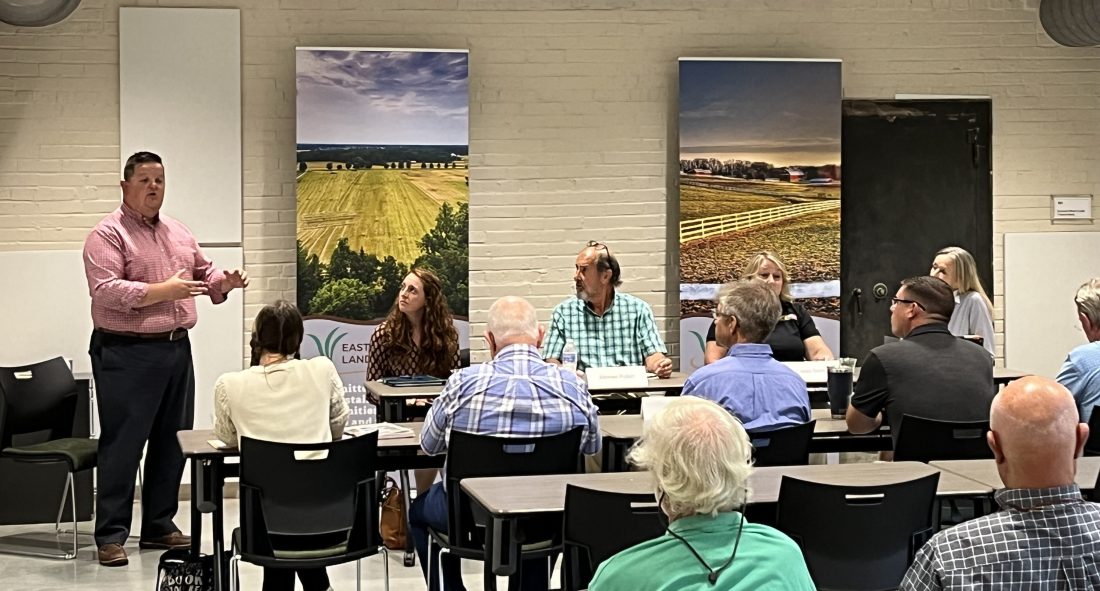Talbot County Council Candidates’ Comprehensive Plan Workshop
Eastern Shore Land Conservancy hosted a first-of-its-kind Talbot County Council Candidates’ Comprehensive Plan Workshop on the evening of Thursday, September 22, 2022, attended by eight of the ten candidates for Talbot County Council. ESLC President Steve Kline facilitated a panel discussion by Lisa Ghezzi (Talbot Planning Commission), Michael Pullen (former Talbot County Attorney), Stephanie Jones (Queen Anne’s County Principal Planner for the Department of Planning and Zoning), and Tracey Gordy (Maryland Department of Planning). This discussion provided County Council candidates an overview of the primacy of Comprehensive Plans and what the next group of county councilmembers should expect from the plan’s approaching re-write.
What is a Comprehensive Plan?
A comprehensive plan (also known as ‘comp plan’) is the foundational planning document for a local government outlining land use, growth, resource management, and other issues required by the State of Maryland. Talbot County Planning Commission member Lisa Ghezzi spoke about consistency in how the current plan is implemented and how it guides decision making at the planning commission, county council, and staff level.
“A comprehensive plan is significant to the future of any jurisdiction or municipality,” said Stephanie Jones. “It drives decision making, regulation changes, and provides support for the vision. Each plan is drafted specifically for the jurisdiction or municipality’s needs, goals, and future endeavors and addresses a long-term planning horizon.”
What Role Does the County Council Play?
Talbot County’s current comp plan was approved in 2016 and the planning process for the 2026 plan will begin during the term of the next Talbot County Council. Comprehensive plans typically take two years to complete from start to finish. With three of the current five council members retiring, the upcoming election will bring a new majority in the council – no matter who wins in November. Though the planning commission and county planning staff will take the lead in drafting the document, it is ultimately up to the county council to formally adopt this vital and mandatory land use document.

Eight of the ten candidates for the Talbot County Council (first two rows facing the panel) listen to conversation with the panelists
What Role Does the Public Play?
Community involvement, transparency, and open meetings are vital in creating a strong plan that represents the goals of a county or municipality. As Tracey Gordy, Director of the Lower Eastern Shore Regional Office of the Maryland Department of Planning stated, “when conducting a comprehensive plan update, make certain the process is transparent and provides multiple opportunities for stakeholder input. Community ownership of the plan is directly related to the degree of public input in the planning process.”
Jones worked for the Kent County Planning office back in 2018 when their most recent plan was adopted; she also worked on the newly-approved Queen Anne’s County Comprehensive Plan from 2022. She spoke about working through pandemic restrictions on public meetings and how the county overcame those obstacles in collecting community input and feed. She also notes that it is rather difficult to get younger generations involved in the planning process – despite how much it will impact the future of their communities, especially in the 25 – 45 age demographics.
What Is the State’s Role?
The Maryland Department of Planning is an important resource to any jurisdiction and provides the necessary data, training for planning commissions, and comp plan review for both counties and municipalities. All plans are reviewed by the Maryland State Clearinghouse, which offers intergovernmental assistance and review to ensure plans are consistent with state and local policies programs.
What is the Impact of the Comprehensive Plan?
A comprehensive plan is not a stand-alone document, as it interacts with other master plans, ordinances, and even comp plans in municipalities. Ghezzi, Gordy, and former Talbot County attorney Michael Pullen spoke on the importance of having consistency with water and sewer master plans and zoning maps. Oftentimes, both are updated after a comprehensive plan is approved in order to ensure consistency, but this does not always happen. Although the Maryland Department of Planning is required to review Comprehensive Plans, they are not required to review Zoning maps.
Occasionally, conflict arises between municipal and county plans, but Pullen noted that such conflicts are normally settled without too much issue, thanks in part to a state process for addressing conflicts between jurisdictions.
Questions and Answers
After the panel gave opening statements, the candidates asked questions of the panelists to help build on their understanding of comprehensive planning, how a planning process is started, and how plans are implemented. The candidates also asked detailed questions on the role that different parts of the government play from the county council to the planning commission, county staff, and the general public.
For more information, follow ESLC for future updates regarding Talbot County’s comprehensive plan and for the Town of Easton’s current Comprehensive Plan.
Click here for the Comprehensive Plan of the Town of Easton
Click here for more information on Maryland Department of Planning education







